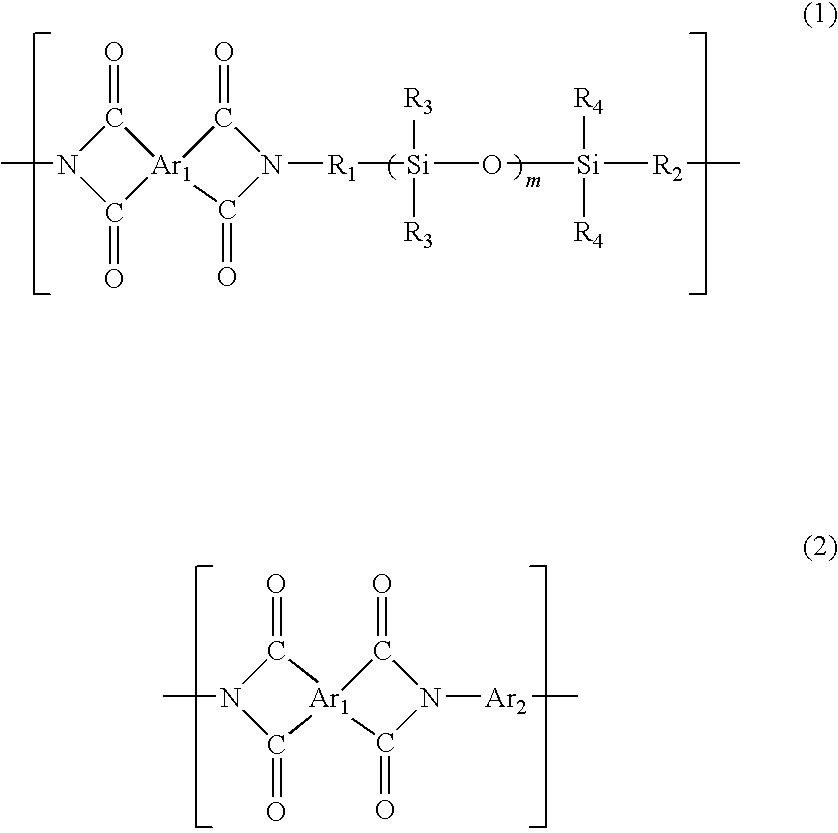Flame-retardant adhesive resin composition and adhesive film using the same
a technology of adhesive resin and composition, which is applied in the direction of adhesives, printed circuits, electrical equipment, etc., can solve the problems of inferior dimensional stability, insufficient chemical resistance of adhesives, and insufficient heat resistance of adhesives, so as to improve the properties of curing resin and the resin resulting from curing the aforementioned flame-retardant adhesive resin composition.
- Summary
- Abstract
- Description
- Claims
- Application Information
AI Technical Summary
Benefits of technology
Problems solved by technology
Method used
Image
Examples
synthetic example 1
[0075]An addition reaction of 20 g of acenaphthylene to 180 g of NA resin was carried out at 100° C. with stirring in a 500-ml separable flask to give 200 g of an acenaphthylene-modified naphthol aralkyl resin. The acenaphthylene-modified naphthol aralkyl resin showed a softening point of 54° C. when measured in accordance with JIS K 2548 and a hydroxyl equivalent (OH equivalent) of 236. The degree of addition reaction determined by GPC was 99% and the rate of substitution of the acenaphthenyl group (the number of moles of acenaphthylene added to 1 mole of naphthalene ring) was 0.4.
synthetic example 2
[0076]In 400 g of epichlorohydrin was dissolved 100 g of the acenaphthylene-modified naphthol resin obtained above and the two were allowed to react at a reduced pressure of 100 mmHg and at 60° C. for 5 hours while adding 40 g of a 50% aqueous sodium hydroxide solution over a period of 4 hours. The water formed in the reaction was removed out of the system by azeotropic distillation with epichlorohydrin.
[0077]Upon completion of the reaction, the excess epichlorohydrin was distilled off under reduced pressure, 450 g of methyl isobutyl ketone was added to the residue to dissolve the epoxy resin, the solution was filtered under reduced pressure, and the epoxy resin was recovered in the filtrate. Thereafter, 20 g of a 20% aqueous sodium hydroxide solution was added and the reaction was carried out at 80° C. for 2 hours. The reaction mixture was then filtered, washed with water, and stripped of the methyl isobutyl ketone by distillation under reduced pressure to give 120 g of a brown ace...
synthetic example 3
[0078]In a 500-ml separable flask was placed 160 g of a phenol aralkyl resin (MEH-7800-4L with an OH equivalent of 162, manufactured by Meiwa Plastic Industries, Ltd.) and the resin was melted at 100° C. To the melt was added 40 g of acenaphthylene and an addition reaction was carried out with stirring at 100° C. for 1 hour to give 200 g of an acenaphthylene-modified phenol aralkyl resin. The acenaphthylene-modified phenol aralkyl resin thus obtained showed a softening point of 59° C. when determined according to JIS K 2548 and a hydroxyl equivalent (OH equivalent) of 184. The degree of addition reaction of acenaphthylene was 99% when determined by GPC and the rate of substitution of the acenaphthenyl group was 0.4.
PUM
| Property | Measurement | Unit |
|---|---|---|
| Temperature | aaaaa | aaaaa |
| Percent by mass | aaaaa | aaaaa |
| Percent by mass | aaaaa | aaaaa |
Abstract
Description
Claims
Application Information
 Login to View More
Login to View More - R&D
- Intellectual Property
- Life Sciences
- Materials
- Tech Scout
- Unparalleled Data Quality
- Higher Quality Content
- 60% Fewer Hallucinations
Browse by: Latest US Patents, China's latest patents, Technical Efficacy Thesaurus, Application Domain, Technology Topic, Popular Technical Reports.
© 2025 PatSnap. All rights reserved.Legal|Privacy policy|Modern Slavery Act Transparency Statement|Sitemap|About US| Contact US: help@patsnap.com



